Some of the links in this post may be affiliate links.
The stunning Alocasia micholitziana ‘Frydek’ is one of the many varieties of Elephant Ear. Commonly known as the Green Velvet Alocasia, few plants match the foliage of the Alocasia genus!
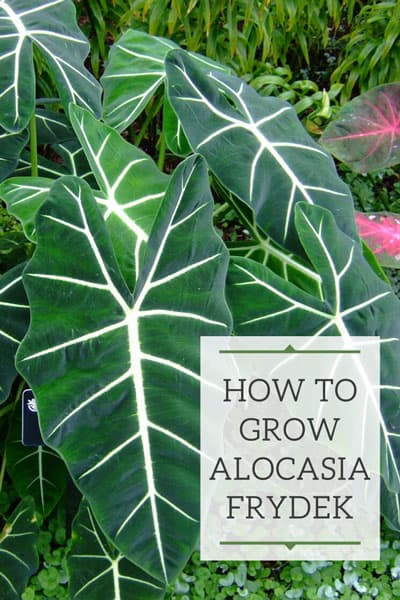
Table of Contents
Alocasia Frydek Care
It is important to be very consistent with the care of these plants, especially if you have a smaller plant. Once the plants are bigger, they will be a little bit more forgiving.
If you don’t have one of these beautiful plants and are wondering where to purchase one, I will tell you shortly! First, let’s get into the care.
LIGHT
These aroids will thrive in bright indirect light, and up to half a day of direct sun. Morning sun, especially in the winter time, is very beneficial.
Try to avoid direct afternoon sun which is harsher. Bright filtered light will work best.
If you have Northern or Eastern windows, it would be safe to have these plants within a couple feet of the window for best results.
You may want to set your plants back a little bit if you have Western or Southern windows that have too much direct sun.
Be sure to regularly turn your plants to allow for even, and better growth. The large leaves will all grow to face the window so if you want a nice, symmetrical plant, this is necessary.
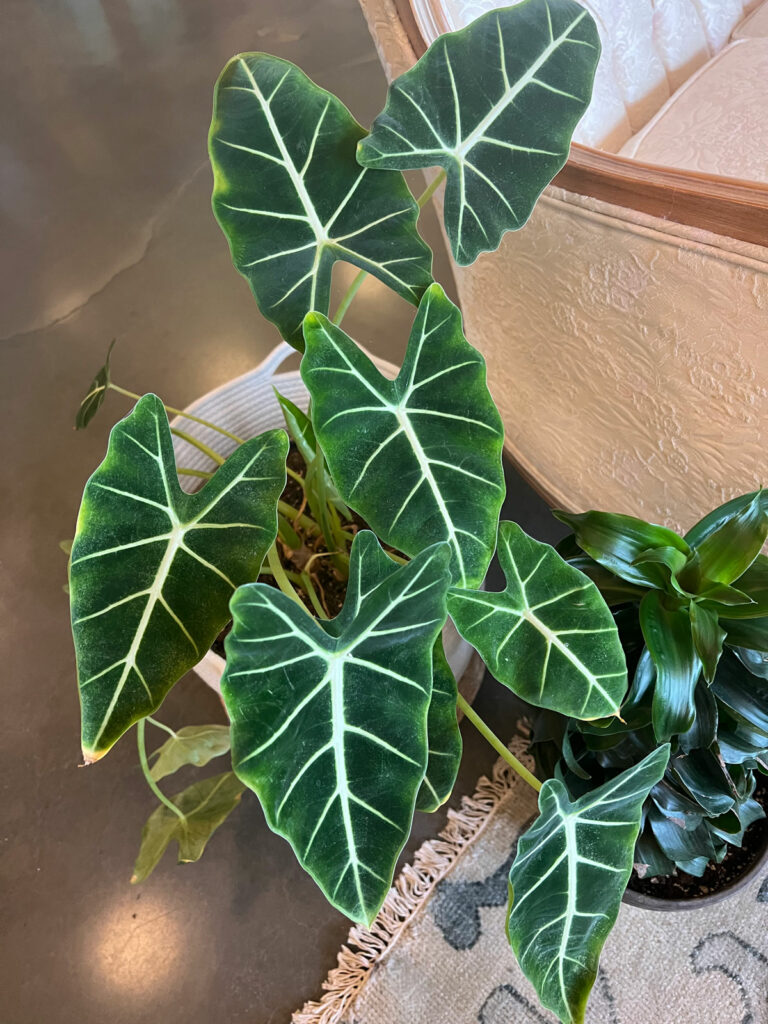
TEMPERATURE and HUMIDITY
Alocasias come from the jungles of southeast Asia, so they like warm temperatures and high humidity if you can provide it.
Minimum temperatures of 60F (16C) or above are recommended. But staying 65F (18C) and above is better because these are warm growing species.
Increasing humidity for houseplants is very beneficial and I like to provide my Alocasias supplemental humidity in the winter time when our indoor air is very dry.
I run my absolute favorite humidifier constantly all winter and I tell you exactly which one I like to use in the blog post that I linked to above!
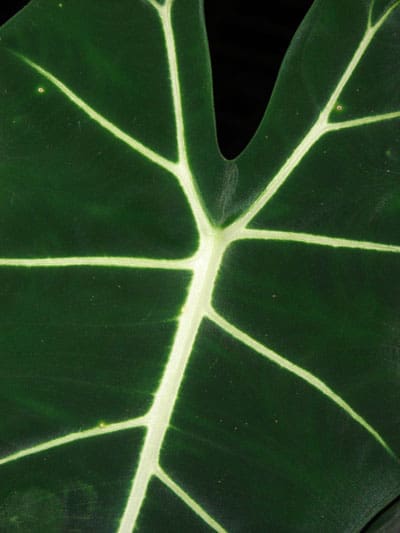
WATERING
Watering is absolutely critical for Alocasias so please read this section very carefully!
It is important to thoroughly soak these plants when you water and all excess water to escape the drainage holes. Discard the excess water.
Wait until the surface of the soil dries out (about the top inch or so) and then promptly water again.
These plants absolutely despise drying out completely so take care not to let that happen. Leave these plant dry for too long, and they will go completely dormant.
SOIL and REPOTTING
A good well-draining soil will work fine for these plants. I do like to add some additional perlite in order to increase porosity and drainage.
My standard ratio for leafy tropical plants is 3 parts of an all-purpose potting mix and 1 part of perlite.
Your Alocasia Frydek likes to stay pretty pot-bound, so there is no rush to repot all the time.
I only repot my Alocasias when they have almost filled out their pots. Even then, when you do repot, I only go up one pot size.
Going up only one pot size is a good rule of thumb in general for houseplants. If you repot into a much bigger pot, you run the risk of the soil taking too long to dry out, and this can contribute to root rot.
FERTILIZING
I use the same fertilizer for all of my leafy tropicals indoors. It is a premium fertilizer, is absolutely amazing if you consistently use it, and is easily available on Amazon.
The fertilizer is from Dyna-Gro Grow and it is a nutritionally complete, urea-free fertilizer that won’t burn your plant and provides amazing growth.
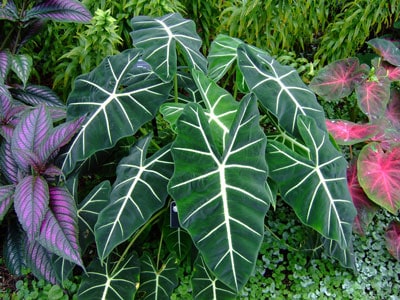
PROPAGATION
The only practical way for the home grower to propagate Alocasia Frydek is to divide the plant at the base whenever you repot.
The best time to repot and divide your plant is in the Spring when new growth is starting to occur.
ALOCASIA PROBLEMS and COMMON QUESTIONS
These are not the most carefree plants out there, so let me discuss the most common problems that you can have with your Alocasia Frydek and what causes them.
SPIDER MITES
Alocasias indoors can be occasionally plagued with spider mites. Spider mites thrive in very dry air, so keep an eye on your plants.
If you regularly mist your plants, it will help to deter spider mites. Misting will not be effective in raising humidity, but it does deter spider mites.
If I have any plants that are prone to spider mites, I try and mist them in the wintertime to help deter pests. I also like to take plants into the shower and give them a good shower.
Check out my spider mite blog post for natural and organic ways to deal with spider mites. I also wrote a post on treating for mealybugs that may interest you.
DROOPY LEAVES
Occasionally, your Alocasia will have its outer leaves start drooping. Don’t be surprised if this happens shortly after you bring your plant back from from purchasing it.
Moving these plants from a greenhouse setting to average home conditions will require a period of adjustment, so don’t be too alarmed if you get droopy leaves.
You may find that your Alocasia in the winter months will suffer a little bit and you may get droopy leaves then too from having lower light and cooler temperatures.
One very common reason for drooping leaves on your Frydek is if your potting mix has gone completely dry like in the photo below.
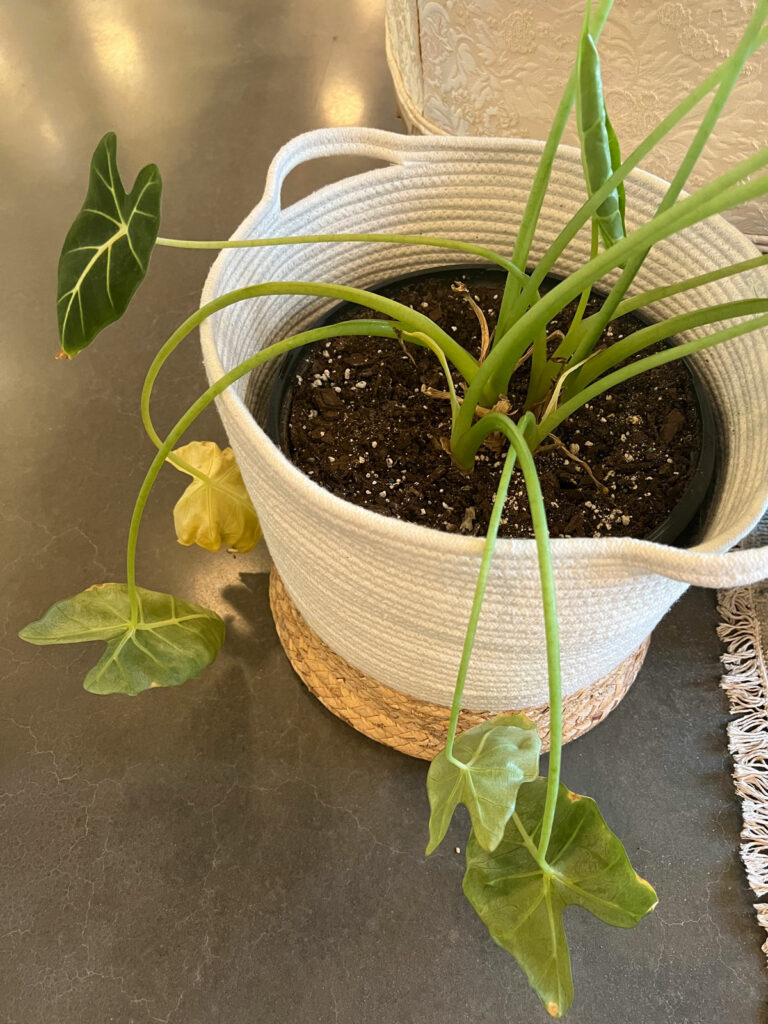
The oldest leaves will start to droop first. If you see drooping, immediately feel your soil and if it’s very dry, give your plant a good, thorough watering.
I like to place all my Alocasias outdoors in the summer and they make a miraculous comeback. The growth can be staggering!
Of course, do your best withe following proper watering and light conditions that I talked about above, and you should be OK!
LEAVES TURNING YELLOW
Yellow leaves in general can be caused by a variety of things including underwatering, overwatering, and keeping your plant too cold.
Check out my blog post on what causes yellow leaves in plants.
If you notice your leaf edges and tips starting to yellow, go ahead and immediately feel your soil. Chances are that your soil has gone completely dry for too long, like in the photo below.
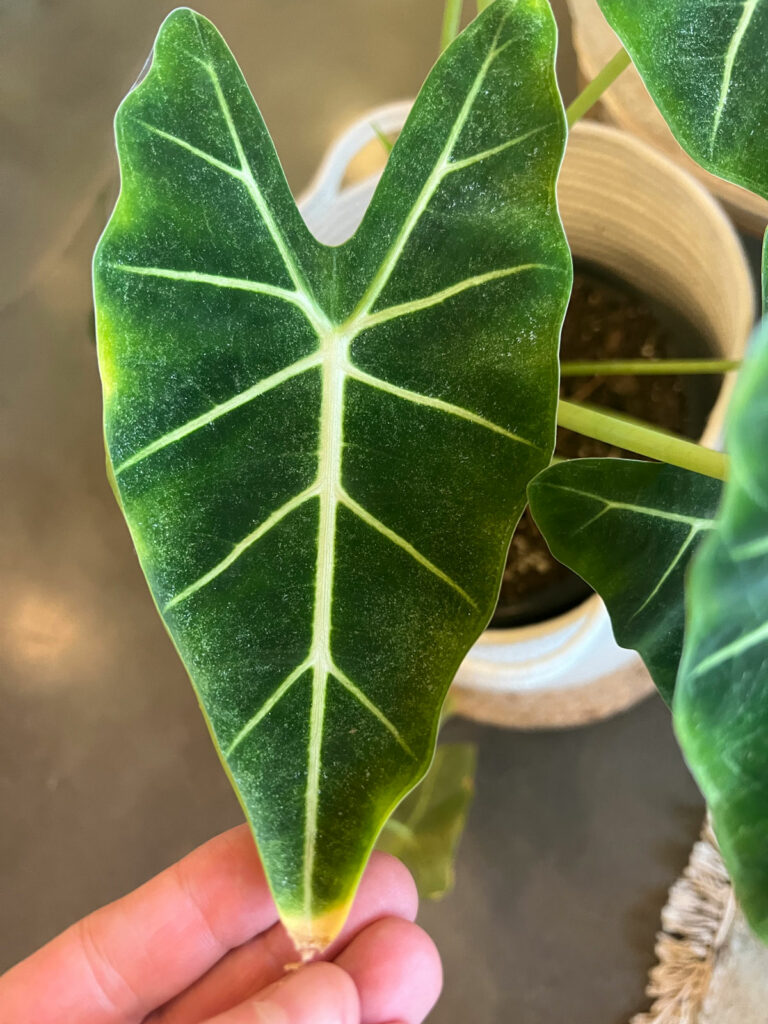
Typically, when the soil dries out too much, the lower leaves will turn yellow first.
ALOCASIAS GOING DORMANT
If your Alocasia Frydek, or any Alocasia for that matter, is stressed, it may go completely dormant.
This can happen if you let your soil go dry for long periods of time and also if you keep your plant too cold. It will simply be forced into dormancy.
If this occurs, don’t despair completely! If all the leaves have yellowed, cut them all off. You will be left with just the base of the plant.
As long as the roots haven’t completely dried out, you plant will grow back with proper watering and light.
After I had neglected my plant (unintentionally), it went completely dormant and it lost all of its leaves. If this happens to you, don’t despair because it doesn’t mean it’s dead! When warmer months returned, I placed my plant back outdoors, and it grew new leaves in a hurry. I placed it in a full shade position. Here is my plant at the end of summer when I placed it back into my greenhouse.
The warmer temperatures, rainwater, bright light and air circulation from being indoors really is the best thing for this tropical plant!
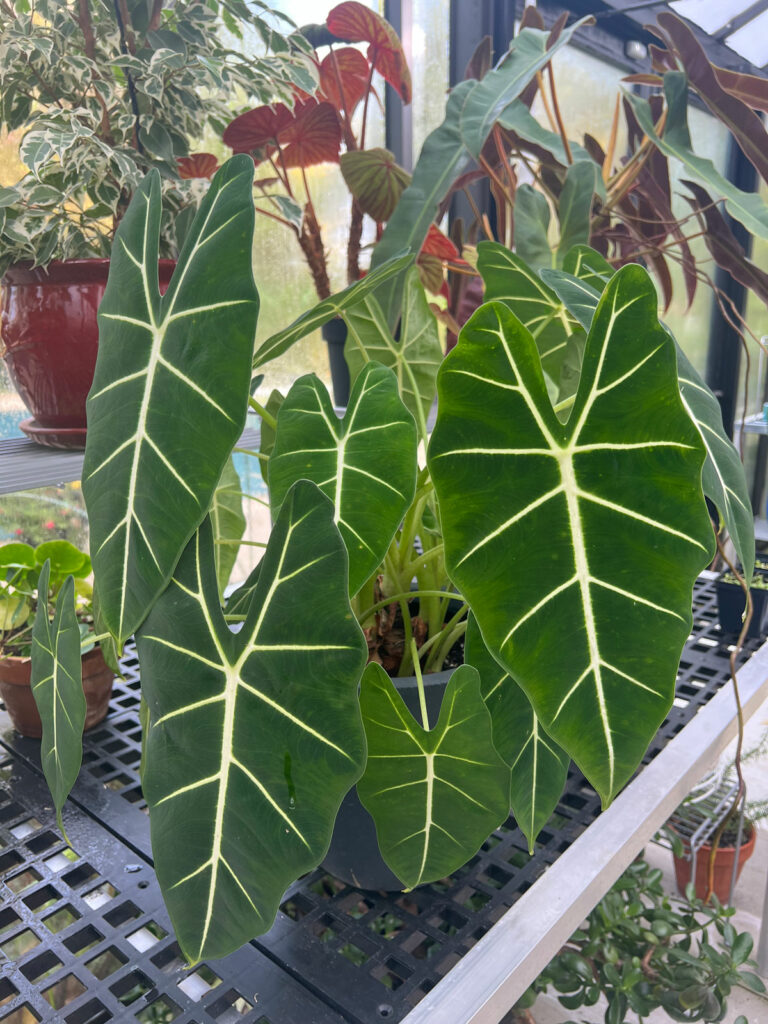
IS ALOCASIA FRYDEK TOXIC FOR PETS?
Yes, this plant is toxic according to the ASPCA. Like all aroids, it contains insoluable calcium oxalate crystals.
ALOCASIA MICHOLITZIANA VS. FRYDEK
Are they the same plant? Frydek is a cultivar (cultivated variety) of Alocasia micholitziana. The species is native to the Philippines.
Do you have an Alocasia Frydek or any other kind of Alocasia? Check out my post on Alocasia amazonica and Alocasia Polly for further information on those plants, or check out my Alocasia types post to explore some beautiful varieties that you can grow indoors.
AIR CIRCULATION
Air circulation is particularly important for many indoor plants. Plants outdoors have the benefit of wind to circulate air for healthy growth. Indoors, we would need to create air circulation by opening windows or by the use of fans.
In my greenhouse where I currently have my Frydek, it is particularly important to provide air circulation because of the humid environment. The more humidity is in the air, the more important it becomes to circulate the air. Otherwise, your Alocasia plants can be easily prone to fungal diseases. I currently have 3 fans inside my greenhouse that I circulate continually.
Inside the home, you can provide gentle air circulation by overhead ceiling fans, or even with a small, portable fan. It is very helpful especially if you have a lot of plants crowded together.

BROWN LEAF TIPS
If you notice brown tips on your Alocasia Frydek plant, it is likely due to the soil drying out too much. These plants do not like dry conditions (both dry soil and dry air). Once the top inch of soil has dried out, go ahead and water. And if you have really dry indoor air (particularly in the wintertime with forced air heat), it would be a good idea to consider increasing humidity levels with a good humidifier.
This plant is not without its quirks, but under the right conditions, it can be a stunning plant to add to your collection.
ALOCASIA FRYDEK FLOWER
Did you know that Alocasia Frydek plants can bloom? It has the typical aroid inflorescence structure. Take a look at the photo of my own plant blooming in my greenhouse below.
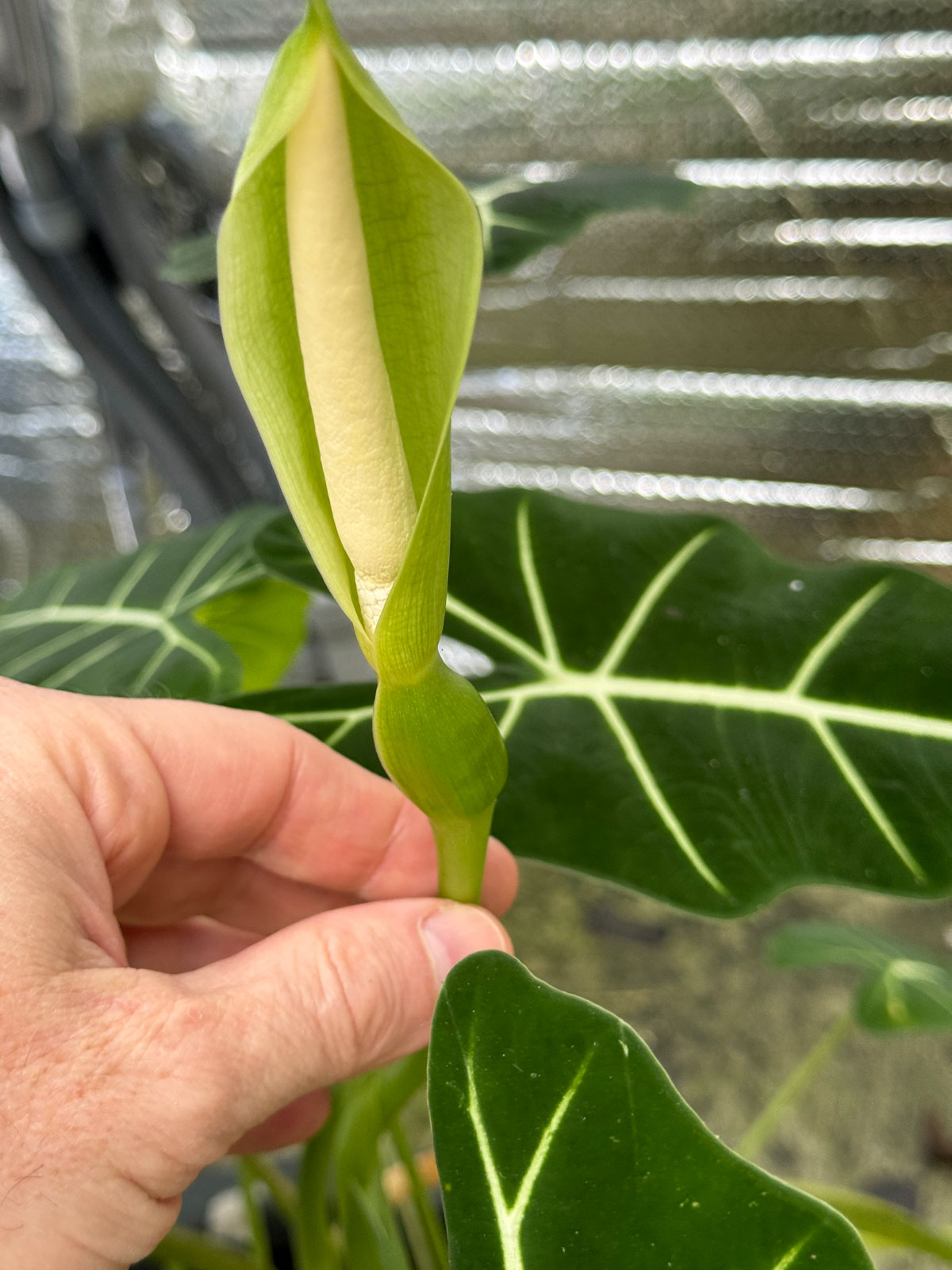
What you see in the photo above is technically called the inflorescence, which is the flowering structure. The white spike that you see in the middle is called the spadix, and the flowers are tiny and found on the spadix.
The spathe is the leaf-like bract surrounding the spadix. In the case of Alocasia Frydek, the spathe is a light green.
Most people call the whole inflorescence the “flower”. And usually when I see any inflorescence appearing, I will cut it off so that the plant doesn’t waste energy on flowering, but rather, can focus on leaf growth.
Check out my post on Alocasia flowers for more details.
Happy planting!

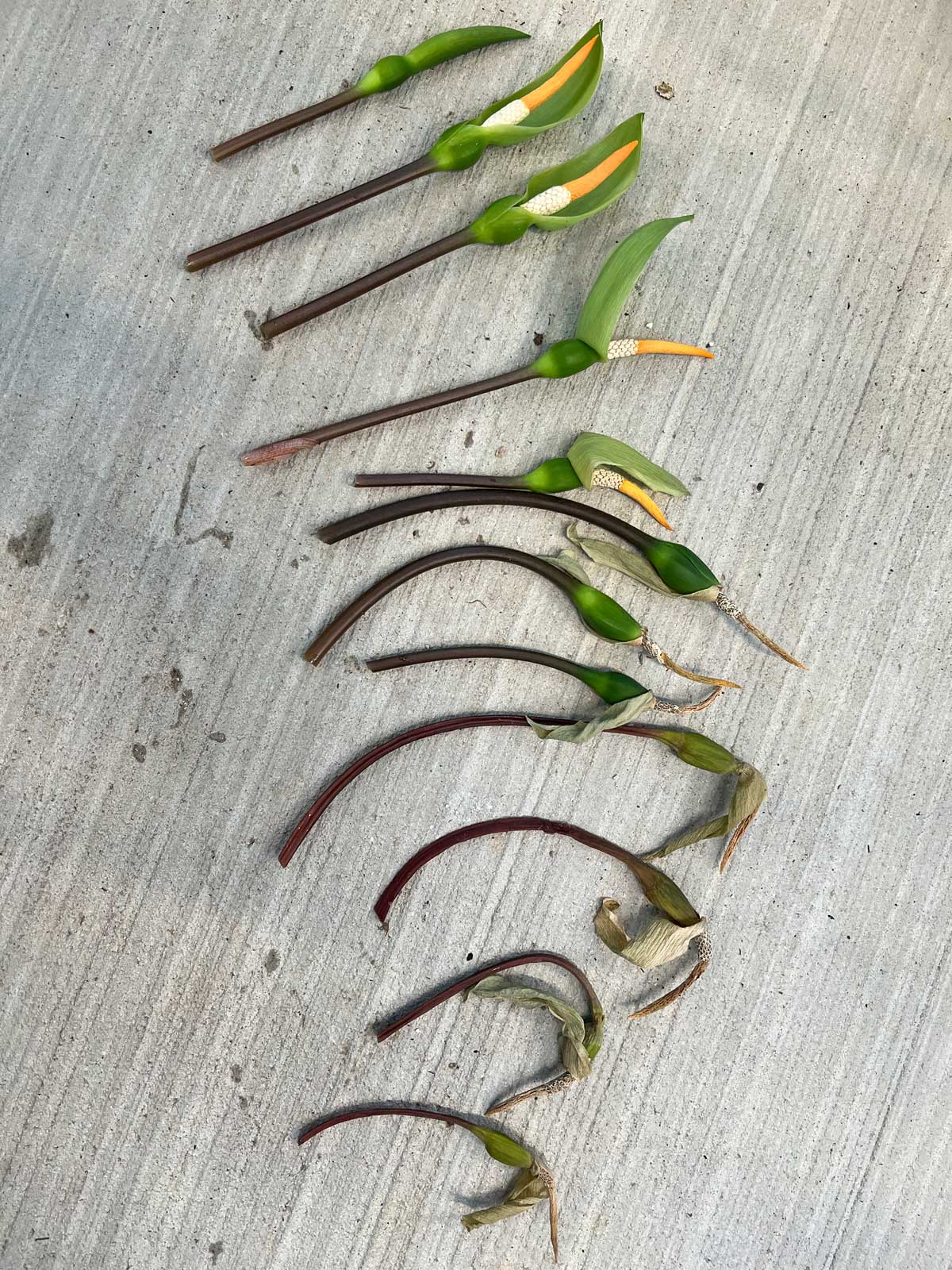
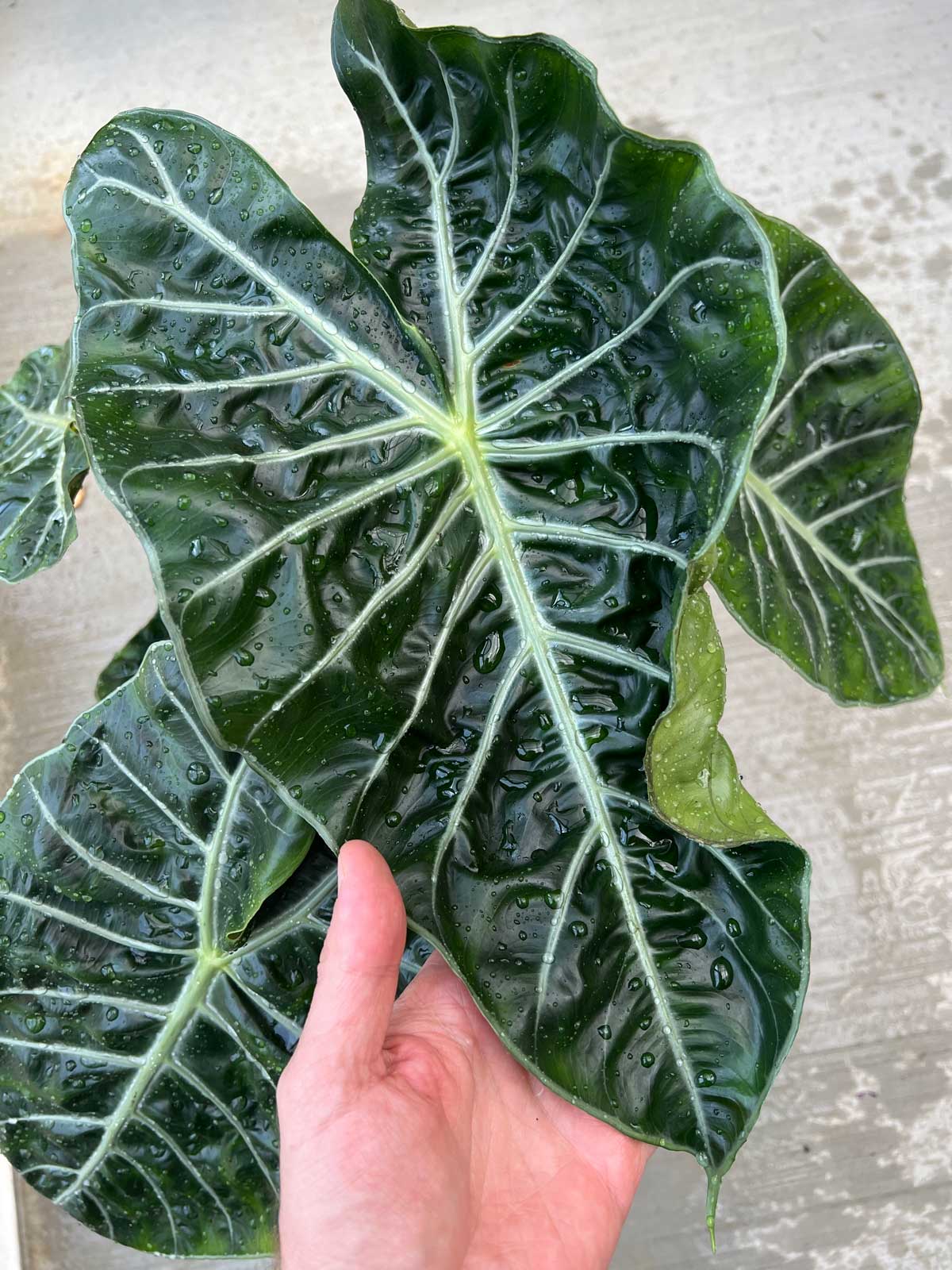
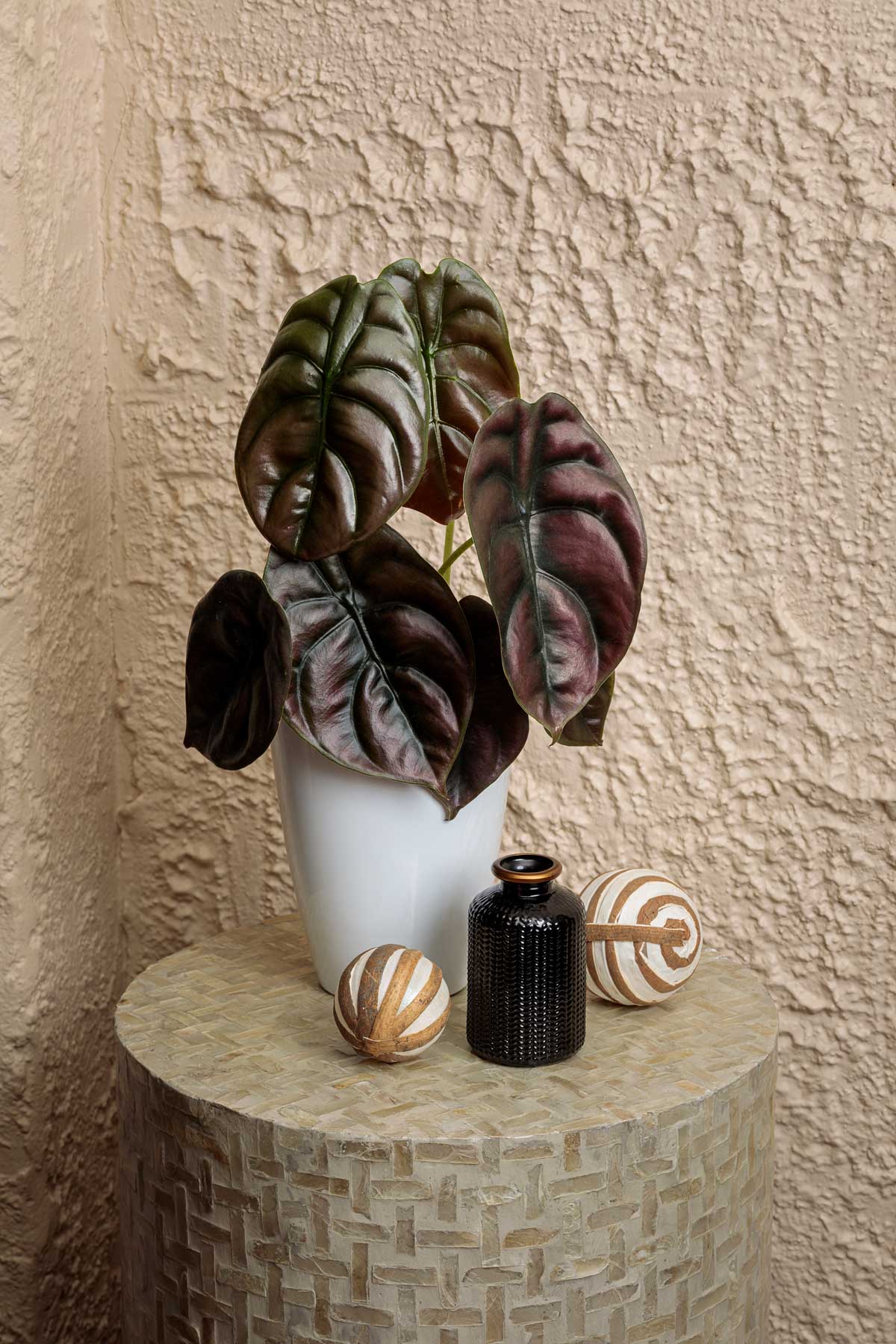
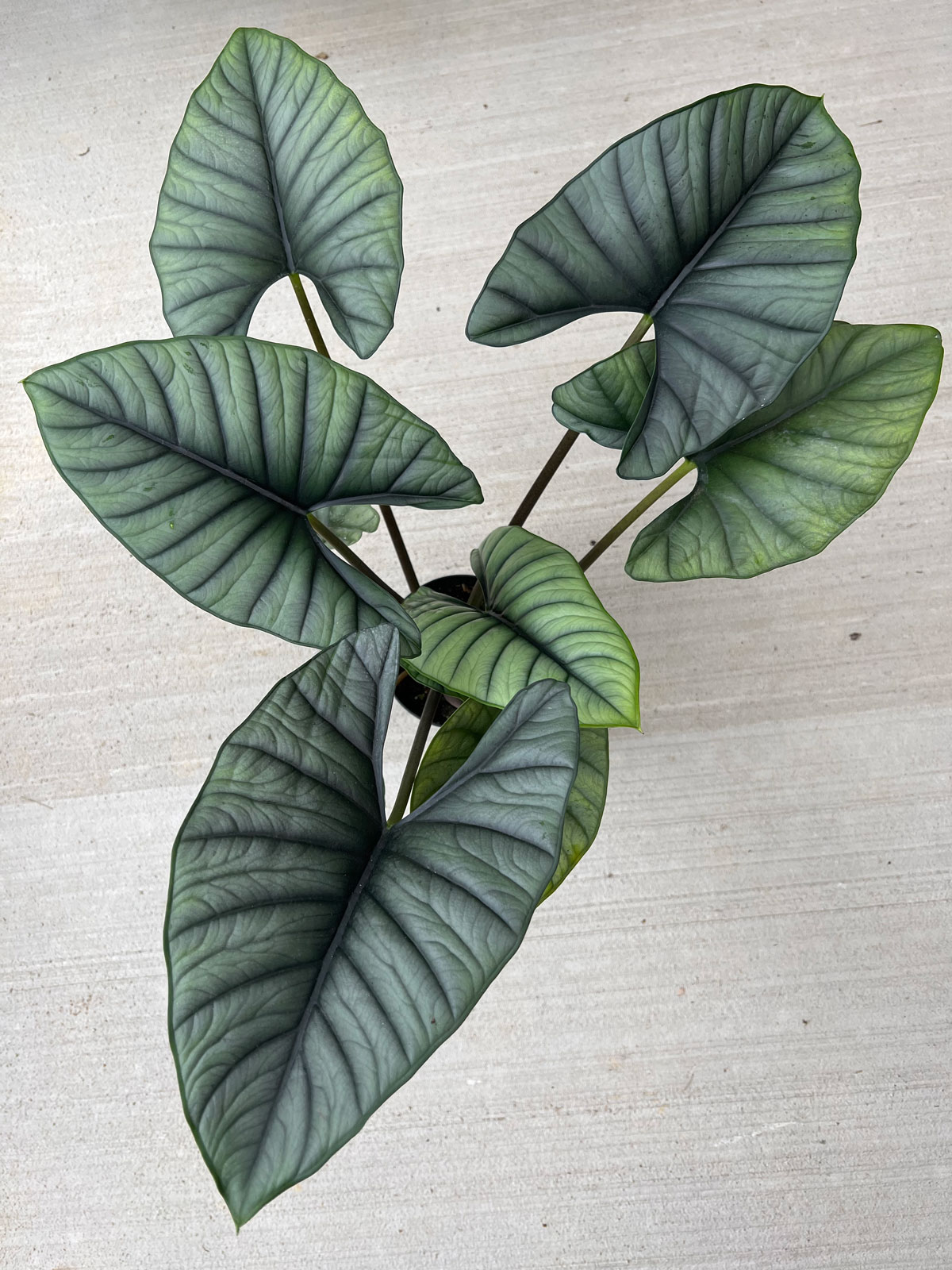
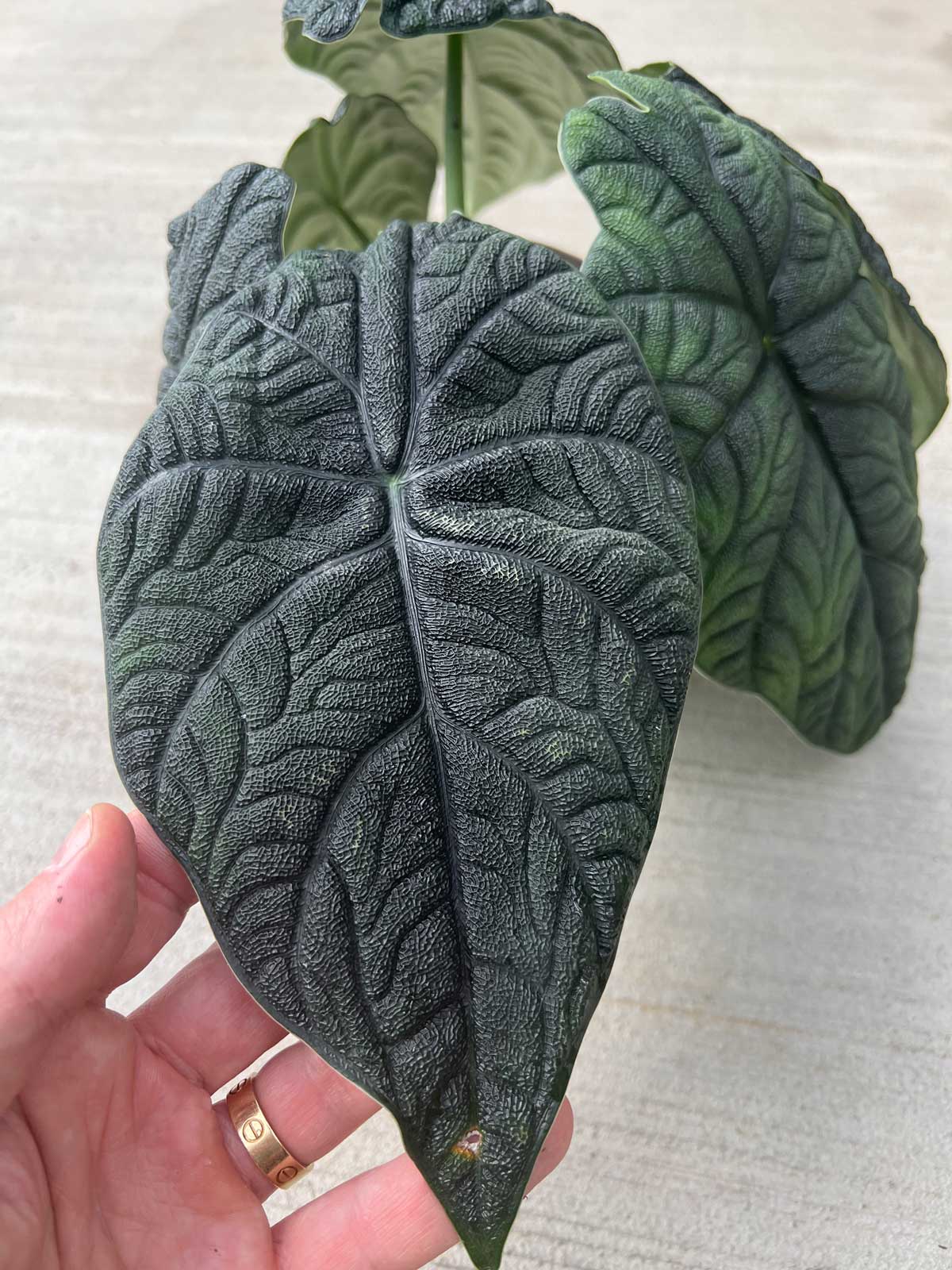
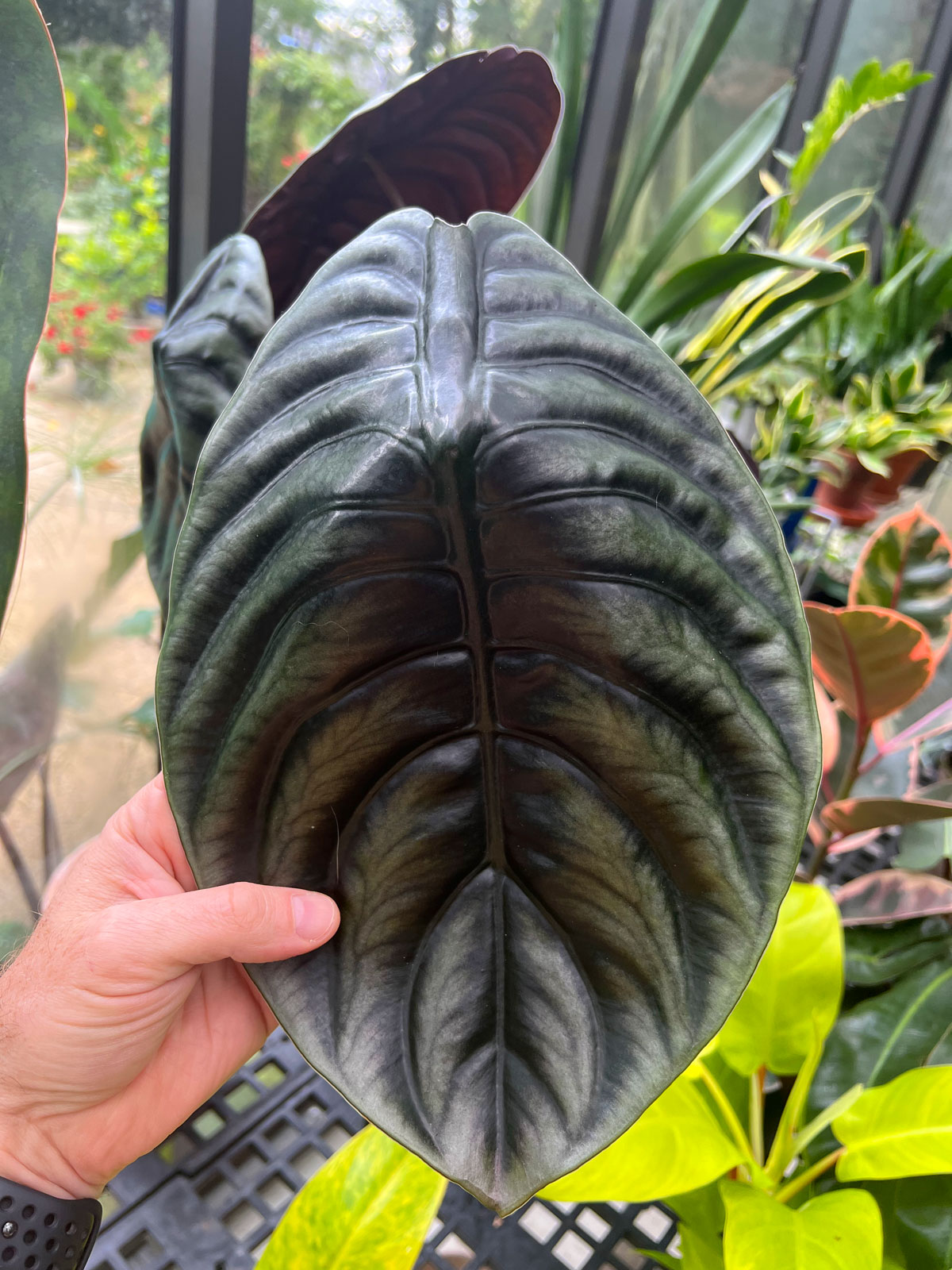
Freddie coviello
Monday 5th of February 2024
This was probably one of THE best reads on Frydek! Thank you! Mine is only about 2 weeks old and I am experiencing the drooping leaves. The soil is damp, not wet. I have her in a living room with an entire wall of South facing windows in San Diego so there is plenty of light (I think). It is either there or a west facing window. Even with the soil just damp, she seems to be guiatatting (sp?) a lot so I haven't used the small humidifier or humidity tray as of yet; I think this is why the tips are slightly brown as well because of the wet tips? Any tips or hints for this beauty are much appreciated
Raffaele Di Lallo
Tuesday 6th of February 2024
Glad you enjoyed the post Freddie! I would give it some time to adjust since your plant is so new to your environment and then evaluate the new growth moving forward :-)
Patricia
Wednesday 5th of May 2021
My Frydek sent up a flower, (a white seed pod) soon after the leaves developed spots toward the tips. My daughter suggested that I cut the flower off to preserve the plants energy. I also sprayed the effected leaves with neem oil.
This plant has only just begun to grow more leaves and even sent up a new little plant. I hate to see any threats to its continued health.
sherry clemens
Thursday 2nd of April 2020
my plant broke off at the base if i plant the top in soil will it reroof
Raffaele
Friday 3rd of April 2020
Hi Sherry! Probably not...It won't root from just a leaf.